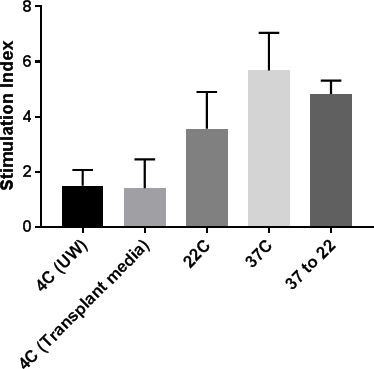Evaluation of Culture/Preservation Conditions on Human Islet Survival and Function
1Department of Surgery, School of Medicine, Virginia Commonwealth University, Richmond, VA
2Hume-Lee Transplant Center, VCU Health System, Richmond, VA.
Meeting: 2018 American Transplant Congress
Abstract number: B76
Keywords: Islets
Session Information
Session Name: Poster Session B: Islet Cell and Cell Transplantation
Session Type: Poster Session
Date: Sunday, June 3, 2018
Session Time: 6:00pm-7:00pm
 Presentation Time: 6:00pm-7:00pm
Presentation Time: 6:00pm-7:00pm
Location: Hall 4EF
Background
Islet transplantation is an effective treatment for type-1 diabetic patients suffering from severe hypoglycemic episodes. Islet culture or preservation post-isolation has been adopted by various centers. However, the effect of islet culture/preservation before transplantation still remains to be determined. Moreover, islet culture seems to be inconsistent with poor recovery for transplantation. In this study, we evaluate the effects of different culture/preservation conditions on islet survival and function.
Methods
High purity islets were cultured or preserved under five different conditions: Preservation at 4[deg]C for 48 hours in University of Wisconsin solution; 4[deg]C for 48 hours in Connaught Medical Research Laboratories (CMRL)-based media; and cultured at 22[deg]C for 48 hours in Prodo Islet Media Standard PIM(S) medium; 37[deg]C for 48 hours in PIM(S) medium; or 37[deg]C for 24 hours followed by 22[deg]C for another 24 hours in PIM(S) medium. Recovery and viability of islets, insulin secretory capacity, gene expression and islet damage were evaluated at 24hrs and 48hrs culture time points.
Results
Islet viability at 48hrs was reduced when islets were preserved at 4[deg]C in either UW solution or CMRL transplant media solution, compared to culture at 22[deg]C, or 37[deg]C. Islet recovery was higher in 4[deg]C preservation conditions compared to culture. Insulin secretory function was also affected at 4[deg]C preservation compared to culture conditions. Inflammatory genes (IL-1b, TNFa, HMGB1) were upregulated at culture conditions 22[deg]C and 37[deg]C but not in 4[deg]C preservation.
Inflammatory genes (IL-1b, TNFa, HMGB1) were upregulated at culture conditions 22[deg]C and 37[deg]C but not in 4[deg]C preservation.
Conclusion
Both culture and preservation conditions may affect islet in different ways. Culturing islets at higher temperature preserves viability and function, but affects recovery and induces inflammatory signals. Whereas preservation improves recovery and prevents inflammatory signal activation but affects viability and function of islets. Therefore it is necessary to evaluate outcome of fresh islets with cultured or preserved islets in clinical setting.
CITATION INFORMATION: Shindo Y., Levy M., Kanak M. Evaluation of Culture/Preservation Conditions on Human Islet Survival and Function Am J Transplant. 2017;17 (suppl 3).
To cite this abstract in AMA style:
Shindo Y, Levy M, Kanak M. Evaluation of Culture/Preservation Conditions on Human Islet Survival and Function [abstract]. https://atcmeetingabstracts.com/abstract/evaluation-of-culture-preservation-conditions-on-human-islet-survival-and-function/. Accessed December 28, 2025.« Back to 2018 American Transplant Congress
